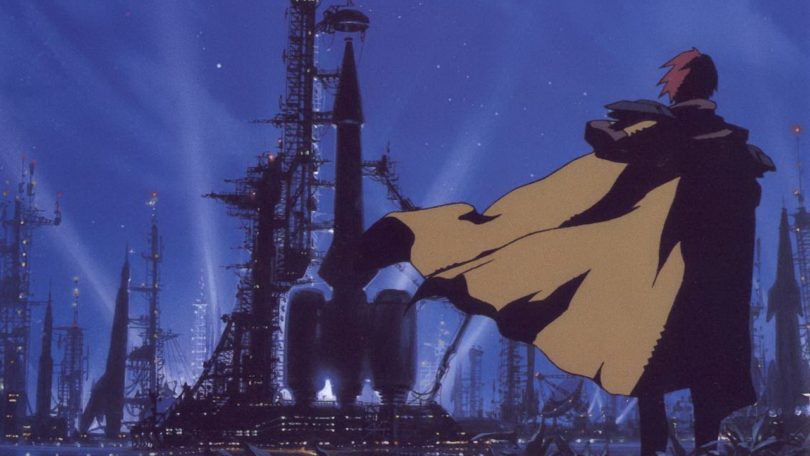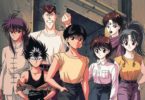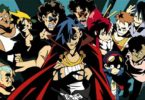If my days as an anime critic are remembered for only one axiom, I suppose the following would suffice: If you can’t have fun with Outlaw Star (1998), you just can’t have fun. Adapted from author Takehiko Ito’s manga, with overall direction by Mitsuru Hongo and original story elements from Hajime Yatate (a collective pseudonym for the production staff of Sunrise), Outlaw Star is a truly standout title of yesteryear.
One of the primary themes of Outlaw Star stresses a simple yet profound truth, which has since morphed into a common platitude of the modern age that is nonetheless important: the essence of life is in the journey, not the destination. Following the many misadventures of one Gene Starwind (whose name is a likely nod to Star Trek creator Gene Roddenberry) and his multifarious crew, the narrative of Outlaw Star takes viewers of any era on a grand adventure aboard an eponymous spaceship. But even though its characters are intrepid explorers traversing the stars on a quest to uncover the Galactic Leyline (a wellspring of untold riches and the source of unfathomable power, according to legend), Outlaw Star continuously emphasizes the metaphorical journey of self-discovery—on the part of its protagonists, and that of its real-world audience—as individuals within the collective comfort of communal networks.
Through the conceptual catalyst of the outlaw, the series does indeed stress individuality (lending to its cult success with Western audiences). As with most romanticized edifices of Anglo-American culture (sea-faring pirates, gun-toting cowboys, what have you), the amoral ramifications of following one’s own moral compass are mostly cast in a positive light rather than being surrounded by an air of neutrality or nihilism. The haphazardly constructed social class of ‘outlaw’ in Outlaw Star is, of course, the proverbial good guy caught in the middle of contrasting powers like the Space Forces (representing legitimate law and order) and the Space Pirates (whose various members are all criminal in nature). Both law-abiding citizens and those involved in the criminal underworld of any society have one key component in common: they both play by a rulebook, and are both subject to the oppression of a hierarchy. The freedom-loving outlaws, on the other hand, play by their own rules and are governed by no authority other than their own autonomy.
In distilled form, this is pure Americana. But unlike its space western peers Cowboy Bebop (1998–1999) and Trigun (1998), Outlaw Star also has a perceptible Eastern flair to its aesthetic. Rather than drawing primarily from Japanese culture and tradition, however, the exotic flavor of Outlaw Star can be chalked up to its many distinctly Chinese ingredients. This is evidenced not only by the names of people and places, but specific historical references as well. For example, the main antagonist of the series, Hazanko, is a master of Tao magic and leader of the 108 Stars branch of the Kei Pirate Guild; the 108 Stars of Destiny are a prominent feature in Chinese author Shi Nai’an’s fourteenth-century novel Shui Hu Zhuan (which, in turn, draws from the Star of Destiny concept of Taoism), often rendered in English as Outlaws of the Marsh. Considering how often Chinese people are caricatured in Japanese media, it is little wonder that this manga-turned-anime depicting a Chinese-centric universe—with iconography, guilds, and even entire star systems tracing their etymological origin to China—was beloved by many people throughout East Asia.
Along with its atmosphere of ancientness (afforded through aforementioned links to the real-life past and episodic delving into various archeological ruins), Outlaw Star also boasts noticeable futuristic elements that have since gone underappreciated in retrospect. In addition to the more obvious aspects like Melfina’s android origins or Harry MacDougall’s cybernetic prosthetics, the series also portrays reality in the abstract not unlike Steven Lisberger’s Tron (1982) during sequences involving the Galactic Leyline. Dissemination of the human mind, a person’s very sense of self, as raw data may have been a staple of cyberpunk by the late nineties, but it was still a fairly novel concept for the layperson at the turn of the century. In several fleeting moments, wherein main characters are forced through arduous forges of introspection, the uncomfortably tenuous relationship between one’s self and one’s physical form are laid bare: Gwen Khan, enraptured with the pursuit of knowledge for its own sake, willingly becomes lost in data; Melfina essentially bids ‘herself’ a fond farewell after constructing her own identity as an individual apart from the avatar of the Leyline; and though he found no worldly treasure, Gene himself finally has his own sense of self defined and his self-worth affirmed, thanks in no small part to his present friends and past mentors.
I’d venture to guess I might end up (figuratively) crucified by fans for saying this (I joke, they’re a jovial lot by and large), but as much as Outlaw Star suffered from being overshadowed by the indelible Cowboy Bebop in its heyday, perhaps the genre-induced affinity—more like shotgun marriage, really—between the two series has, in hindsight, actually helped its memory survive well into the twenty-first century. For though its quality would in no way differ were it released after Shinichiro Watanabe’s magnum opus, in this hypothetical scenario, without such indirect support, I fear Outlaw Star would have gone the way of Goro Taniguchi’s Gun x Sword (2005): a forgotten classic, never really given a chance to shine. In all fairness, perhaps its run on the venerated Toonami lineup would have been enough to sufficiently sear an emotional imprint onto the minds of its viewership.
Though it may already seem the case that time has passed it by all the same, the legacy of Outlaw Star is indeed lasting, albeit a latent one. It may not be directly observable past Sunrise Studio’s spin-off Angel Links (1999) (which is also based on a manga by Ito), but it is arguably detectable in trace amounts. Joss Whedon’s live-action space western Firefly (2002) will forever be a contentious topic among Outlaw Star aficionados; regardless of the fact that he has never, to my knowledge, readily admitted anything of the sort, I would personally bet real money (or dragonite, if ever I got my hands on some) that this creative juggernaut of our time was surely, if only to a minute degree, inspired by Outlaw Star or, at the very least, the emergence of the space western trend in Japan. Unless one is able to consult the Galactic Leyline itself, I guess we’ll never know for certain.
As cliché as this may sound, Outlaw Star really is, in most respects, a product of its time. Takehiko Ito’s opportunity to create a take on outer space that was slightly more mature than his prior manga Future-Retro Hero Story (1988) proved to be serendipitous. It made perfect source material for an animated production that fit snuggly within the evanescent space western fad of Japan and the global zeitgeist surrounding a forthcoming new millennium. In the 1990s, sci-fi was white hot in terms of popularity in both the East and West, while the prospects of space exploration and colonization were among a myriad of seemingly tangible real-world goals: the future was right around the corner, and the fantastic dreams of generations past seemed to be nearing their fruition. In the U.S., I dare say there was a sort of Volksgeist, a shared enthusiasm rooted in a unique culmination of pioneering spirit, faith in technology, and a lingering ethos of manifest destiny that was regularly reflected in our television programming. In many ways, I yearn for the hopeful ambition we’ve seemed to have lost; our collective passion for the stars appears to have ostensibly waned, at least in pop culture.
But while fads come and go, Outlaw Star endures. Its inspirational messages of exploration and personal discovery are ageless, as are its charming characters. Even stylistic elements, including the grappler-arm combat of starships and seamless blending of science and magic, remain exceptional to this day. It may be a perfect time capsule of aesthetics, ideas, and production techniques of the past (and for these alone, I would adore it forevermore), but above all else, Outlaw Star is, and always shall be, a timeless adventure tale of unlikely scoundrels banding together to make their way in the universe—all while trying to figure out what it is they really want out of life. Profound punk, Outlaw Star is good Seinen set in space, unassuming in its rebellious identity; it is fun incarnate, plain and simple.
© 2017







